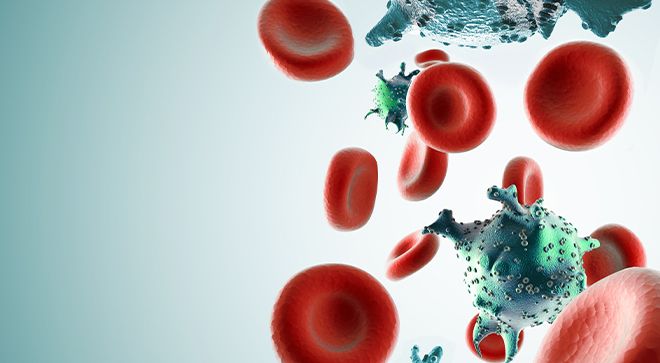Article
Combinations Look Promising in Early Studies of Multiple Myeloma
Author(s):
In an interview with CURE, Craig Hofmeister provided insight into the potential for combination regimens in relapsed/refractory patients with multiple myeloma.
Findings from early clinical trials are demonstrating the strong potential of two combination regimens for patients with multiple myeloma.
In a phase 1/2 study presented at the 2015 American Society of Hematology Annual Meeting,1 the combination of Revlimid (lenalidomide) and the anti—PD-1 monoclonal antibody pidilizumab (formerly MDV9300; CT-011) demonstrated tolerability and clinical activity in patients with relapsed/refractory multiple myeloma. Among 12 evaluable patients, there were three very good partial responses, one partial response, two minimal responses, and two occurrences of stable disease.
This is the first reported combination with an anti—PD-1 therapy for multiple myeloma, the study authors noted.
A second combination study examined Reolysin, an oncolytic virus, plus Kyprolis (carfilzomib) and dexamethasone in patients with relapsed multiple myeloma.2 In the phase 1 study, the triplet was found to be well tolerated and showed evidence of objective response in 86 percent of patients.
Both trials, though early, are generating excitement as potential options for relapsed patients who may be refractory to existing therapies, explains Craig Hofmeister, an author on both studies.
Can you discuss the phase 1 trial of Reolysin in patients with relapsed multiple myeloma?
In an interview with CURE, Hofmeister, assistant professor of Internal Medicine, Division of Hematology, Department of Internal Medicine, at The Ohio State University Wexner Medical Center, discusses these two clinical trials and the potential for these regimens in relapsed/refractory patients with multiple myeloma.Hofmeister: This is a phase 1 clinical trial looking at patients who have relapsed disease. Some of them are refractory to Kyprolis, and some are not. It is a combination of Kyprolis with the oncolytic virus Reolysin, which is the proprietor form for Reovirus.
We enrolled a small number of patients — just 12 — for this combination at two different dose levels. These included the starting dose level and a dose-level decrease that occurred during the clinical trial. At the starting dose level, every patient had a response. At the dose-level decrease, only some of the patients responded. The majority did not at a lower dose level, which was an unexpected result.
What are going to be the next steps with this trial?
We were very excited about the combination because, at the first dose level, patients continued to remain on therapy without progression. This was only about six patients, but it was remarkably well tolerated and incredibly effective in patients who were Kyprolis-refractory in a small population.We’re hoping to gather more efficacy data in the Kyprolis-refractory population, and we are also interested in finding the right dose. Dose seems to matter quite a lot when giving this oncolytic virus. Therefore, we’re interested in finding the right dose before we explore the true definitive efficacy setting.
The people who had a lower dose did not respond as well, or at least the response was short-lived. The majority of those who were treated at the original dose stayed on therapy.
What are the biggest remaining questions with this drug?
What is Reolysin’s mechanism of action?
There are differences between millions and billions of particles of virus that are infused, and we didn’t expect that there would be such a big difference in response with the decrease.This drug has been tested in a number of solid tumors; this is the first hematologic malignancy trial that is being tested, and only in myeloma. There are many questions for this drug. We need to know how it works, what the best patient population is, and what the right dose is.From what we know, Reolysin specifically enters myeloma cells. We know that it needs some type of cellular stress, something like Kyprolis to make the Reolysin produce an infection, which ultimately leads to cell death. We found this after patients were treated with the drug on day 1; we repeated the marrow one week later and saw productive infection just inside the myeloma cells.
There was a phase 1/2 study looking at Revlimid in combination with pidilizumab. Can you discuss these findings?
Therefore, we were pretty sure about the mechanism of action, at least in terms of what leads to an infection, which kills the cells. Now, we need to figure out how to enhance this cell kill. Does it need to be combined with other agents? Can we get the right dose?This is a really interesting combination. This was an efficacy test for pidilizumab and Revlimid in patients with relapsed myeloma—to examine how well the patients respond and to understand the mechanism in these patients.
This enrolled a small number of patients (12) and all of them had to have prior Revlimid-sensitivity, or at least not be refractory to the full dose of 25 mg Revlimid.
Will there be more studies examining PD-1 inhibitors either alone or in combination for patients with myeloma?
Overall, what are some exciting advancements in the field of myeloma?
Overall, these patients tolerated pidilizumab incredibly well. The vast majority of the side effects were related to standard Revlimid dosing, and the majority of patients responded. Only two patients had stable disease, and everyone else had some sort of monoclonal-protein response, many of them being quite durable even after stopping.There are many PD-1 inhibitor combination trials that are in start-up and some of them are ongoing, and already combining them with every other known drug in myeloma. It is likely that we will see a boost in efficacy, but the question is, 'What is the right partner?' And, I’m not sure how many of these trials will test the right dose.We have had three drugs approved by the FDA recently, which is a first in multiple myeloma — ever. We are incredibly excited about that. Darzalex (daratumumab) remains a blockbuster drug for myeloma in that its single-agent activity is approximately 30 percent in very refractory patients and their duration of response is excellent, at around seven months. Darzalex is a new mechanism of action, as it is the first monoclonal antibody approved for myeloma, and it has wonderful single-agent activity.
Ninlaro (ixazomib), the first oral proteasome inhibitor, will provide patients — if they can afford it — a convenient way to get this mechanism and this mode of attack to their myeloma cells. It is not neuropathic, and it will be a huge boom if patients are able to achieve that three-drug combination at home. It will provide immense flexibility and an improvement in quality of life.
Empliciti (elotuzumab) is another monoclonal antibody that seems to have some benefit when in combination with Revlimid.
References
- Efebera YA, Rosko AE, Hofmeister C, et al. First interim results of a phase I/II study of Revlimid in combination with anti-PD-1 monoclonal antibody MDV9300 (CT-011) in patients with relapsed/refractory multiple myeloma. Presented at: 2015 ASH Annual Meeting. December 5-8, 2015; Orlando, FL. Abstract 1838.
- Sborov DW, Pichiorri F, Nuovo GJ, et al. Reolysin combined with carfilzomib for treatment of relapsed multiple myeloma patients. Presented at: 2015 ASH Annual Meeting. December 5-8, 2015; Orlando, FL. Abstract 1835.




